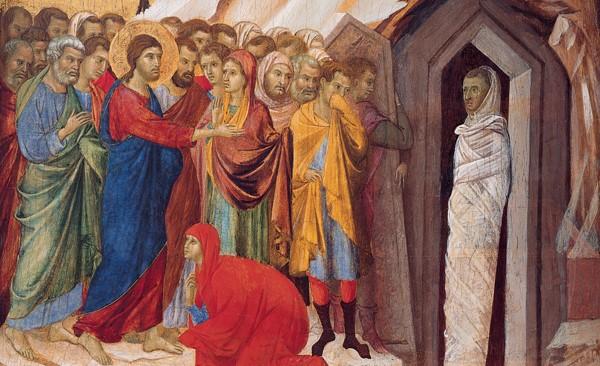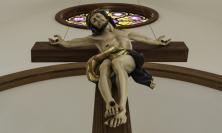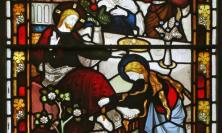On the fifth Sunday of Lent in Year A, we hear the third of the Lenten narratives from John’s Gospel that have been used for centuries in preparation for the reception of the newly baptised at the Easter Vigil. It is the story of Jesus’s gift of life to his friend Lazarus, which is a powerful reading at any time, writes Brian Purfield, but these are not ordinary times. How can it speak to us in our current situation?
A reminder of the story (John 11:1-45)
Jesus hears that his friend Lazarus is ill. Despite the disciples’ urging, Jesus does not rush to his side, but waits two days before heading for Bethany, the home of Lazarus and his two sisters, Martha and Mary. When Jesus finally decides to go to Bethany, the disciples urge caution because it is near Jerusalem, where there is a danger to Jesus’s life.
On his way Jesus is met by Martha who has heard that he is coming. She rushes to meet him and tells Jesus that Lazarus has died and has been in the tomb four days. Yet she says, ‘Lord, if you had been here, my brother would not have died, but even now I know that God will grant whatever you ask of him’ (11:21). When Jesus promises Lazarus will rise again, but makes no promise that it will be now rather than in the afterlife, Martha affirms her belief that Jesus is ‘the Christ, the Son of God, the one who was to come into this world’ (11:27).
Mary is waiting at home with the mourners who have come to share her sorrow. Martha returns and tells Mary that Jesus is on his way. Hearing this, Mary and the mourners go to meet Jesus and, distraught with grief, Mary throws herself at Jesus’s feet, overcome by heartache and anger. She seems to rebuke him: ‘Lord, if you had been here, my brother would not have died’ (11:52). Mary uses almost identical words to Martha, but there is no affirmation of faith in Jesus. Mary’s and the mourners’ reactions greatly distress Jesus; he bursts into tears.
Nevertheless, he is not deterred. On reaching Lazarus’s tomb, despite Martha’s protests that after four days the smell of Lazarus’s body will be overwhelming, Jesus commands the stone be removed and calls to Lazarus to come out of the tomb. At Jesus’s word, still bound by his burial cloths, Lazarus comes out. Jesus tells the onlookers to unbind Lazarus and let him go free from the captivity of death.
How does this story speak to us in our present circumstances?
‘Lazarus, come out!’ (11:43)
We don’t know the cause of Lazarus’s death. We do know he was in the tomb, dead, for four days. To the witnesses at Bethany, his raising was nothing short of miraculous. Even more so as the Jewish understanding was that the soul lingered with the corpse for three days, until the body burst open, then it left the body.
What must it have been like in that tomb with Lazarus? On his death, Lazarus’s body would have been washed, wrapped in burial cloths and anointed with oils. After four days his body would have started to decompose and the tomb, a cave in which Lazarus’s body had been laid, would have begun to smell horribly of the stench of death. For these reasons Martha warns Jesus not to have the covering stone removed. Furthermore, the Jews would have regarded Lazarus’s body as ritually unclean and not to be touched under any circumstances. Not only would the stench of Lazarus’s decaying body have been present in the tomb, but no light would have penetrated the covering stone and the tomb would have been in total darkness. This place was the embodiment of death from which there could be no escape.
At this time of enforced isolation, we may reflect on our own lives. We may see much goodness, life and light in our lives, perhaps we’ll also see parts of our behaviour where we have become strangely more comfortable in the stink and darkness of the tomb. Maybe we have become so comfortable living in this dark space that we’re afraid to come out into the light and life-giving fresh air of God. It is often easier to hold on to our bitterness and ill-feeling towards others than to swallow our pride and admit our failings. It is easier to hold on to broken and difficult relationships than to reach out to each other for healing in love. It is easier to blame ourselves, to hold on to our own guilt, than to accept the forgiveness of a loving and tender God. But these are all signs of death, not signs of life.
Jesus asks: ‘Where have you put him?’ They reply: ‘Come and see’, the very words Jesus said to the two disciples who asked where he was staying (1:38-39). When Jesus says, ‘come and see’, he brings them to a new life; when they say, ‘come and see’, they bring him to a tomb! But the Prologue of John’s Gospel reminded us that the word is light and that: ‘The light shines in the darkness, and the darkness did not overcome it’ (1:5). In the darkness and isolation of his tomb, Lazarus hears the word of God calling him to light and life.
‘I believe that you are the Christ, the Son of God’ (11:27)
In the raising of Lazarus, we witness Jesus’s divinity and we also see his human side. When the sisters send a message to tell Jesus that Lazarus is ill, their words are revealing: ‘Lord, the man you love is ill’ (11:3). Lazarus is not some stranger or mere acquaintance. He is loved by Jesus. Jesus calls him ‘our friend’ (11:11). John says: ‘Jesus loved Martha and her sister and Lazarus’ (11:5). Later, when Jesus meets Mary on the road, he is so distressed at the sight of her grief and the grief of those mourning with her, that he weeps (11:35). John does not hide Jesus’s humanity, and Jesus does not hide his own vulnerability.
Knowing the deep emotional bond between Jesus and Lazarus’s family, Jesus’s response on hearing the news of Lazarus’s illness is surprising. He doesn’t rush to his friend’s side but stays where he is. This seems to go against any claim of friendship or love Jesus had for Lazarus. When we know someone we love is in distress, we want to be with them. But Jesus doesn’t seem to show any sense of this urgency. Later, when the disciples assume Lazarus is resting, Jesus bluntly tells them, ‘Lazarus is dead’ (11:14). If this were the case, perhaps Jesus would be justified in taking his time getting to Bethany: Lazarus would be raised from the dead no matter when he arrived. This may be one possible explanation.
But Jesus loved not just Lazarus but also Martha and Mary. To delay going to Bethany without good reason would be at best insensitive and at worse callous in the context of his reaction to Lazarus’s grieving sisters. Given Jesus’s reaction on seeing Mary’s grief and that of the mourners, it would also seem to be contradictory. Jesus is not ignoring or denying his natural humanity, his natural desire to rush to Lazarus’s side and to comfort Martha and Mary, but has to overcome this desire for some greater purpose, some greater part of God’s plan.
Jesus also had to struggle with a natural, understandable fear. Bethany was very near Jerusalem, probably less than a morning’s walk. Jesus had left Jerusalem to go to the far side of the Jordan because, having confronted the Jewish authorities in the Temple (8:59), the people were threatening to stone him. His disciples knew there was a real danger to Jesus’s life. When Jesus decides to travel to Judea to see Martha and Mary, the disciples are alarmed: ‘Rabbi, it is not long since the Jews were trying to stone you; are you going back there again?’ (11:8) Yet Jesus, while not denying these very real emotions, sets them to one side. He overcomes them for a higher purpose, a greater good.
This greater purpose is linked to bringing the community at Bethany into a closer relationship with God the Father: ‘it is for God’s glory’ (11:4). Perhaps God’s plan is why Jesus, attuned to the Father’s will, sacrifices his own natural and human desires for those of his Father. He sacrifices them so that, through the raising of Lazarus from the dead (rather than just healing him before his death), those who witnessed the event would come to believe. Before calling Lazarus from the tomb, Jesus prays, ‘Father, I thank you for hearing my prayer. I myself knew that you hear me always, but I speak for the sake of all these who are standing around me, so that they may believe it was you who sent me’ (11:41-42). Jesus directs our gaze not to himself but to his Father, and through his action we can come to know the Father better.
‘Jesus loved Martha and her sister’ (11:5)
Mary and Martha are very different in character. When Jesus visits the family before Passover, Mary is seen as the far more emotional sister. In the raising of Lazarus we see her falling at Jesus’s feet in pain and anguish: she seems to rebuke him for being late. ‘Lord, if you had been here…’ – how often have we uttered those words? Later we see a different but equally emotive side when, after the raising of her brother, she again falls at Jesus’s feet – this time to anoint them with precious oils. There seems to be no middle ground with Mary. We see only demonstrations of anguish and joy.
Martha is far more level-headed, more rational in her approach. She goes to meet Jesus alone. There is no demonstrable show of sadness; neither does she overtly plead for Jesus to raise Lazarus from the dead. Her response is almost a rational and accepting faith in Jesus and in God’s will: ‘but even now I know that God will grant whatever you ask of him’ (11:22). No demand, just an acceptance that God’s will be done, not hers. Later, when Jesus visits Bethany, while Mary anoints Jesus’s feet, wiping them with her hair, John tells us Martha did not take centre stage; rather, ‘she waited on them’ (12:2) as they ate dinner. Martha seems to lack the demonstrable passion of Mary. In her we see a thinking, faithful and purposeful person, focused on the task at hand.
Most of us, if we’re honest, have elements of both Mary and Martha: the rational and the passionate, the thinking and the emotional.
‘He called Lazarus out of the tomb’ (12:17)
Lazarus is a key figure in John’s Gospel. It is because of Lazarus being called forth from the darkness and death of the tomb that Caiaphas convinces the Jewish authorities that Jesus must die (11:50). Yet while key, he only appears in the final moments of the story. For much of the narrative he is hidden from view, in the darkness of the tomb. Yet we are left in no doubt of his presence throughout the events in Bethany. What do we know of Lazarus?
We know that he lives with his two sisters, which at that time would not have been uncommon. There is no mention of a wife or children and, perhaps from the fact that it is Martha who waits at the table when Jesus visits Bethany, we can infer that he has neither. What we know for certain is that Lazarus is loved. He is loved in life and in death; he is loved by Jesus and by his sisters; and he is loved by the large crowd of mourners who come to wait with Mary and later meet Jesus on the road to Bethany. In his life Lazarus was a sign of love. In his death he becomes much more. He becomes a sign of conversion.
After his raising, Lazarus becomes a sign of hope and expectation. Crowds gather at Jerusalem to welcome Jesus because they have either witnessed the raising of Lazarus or have heard of the sign and now believe. But for this to happen Lazarus had to die. Without his death he could not have become a point of conversion for so many others. Yet this is not the resurrection of Lazarus but his recall to life. Resurrection is rising to glory and never having to face death again. When Jesus rises, he leaves his grave cloths behind. Lazarus emerges from the tomb still wrapped in his. Yet Jesus has the power to call us out of our tombs.
Jesus’s followers unbind Lazarus and in so doing they ignore the old law, for they touch what is ritually unclean. By acting on Jesus’s command, they accept the new law of the new covenant. They act as the agents of Lazarus’s liberation from death and the imprisonment and darkness of the tomb. We, too, as followers of the risen Christ, must be agents of liberation. From experience we know that we do not have to be dead physically to be in need of being raised. We can be dead in the midst of life, hoping for a word of life and a community that will help put us together again. Jesus’s voice calls us away from making the tomb our natural home and challenges us to take responsibility for our brother or sister who, like Lazarus, is loved by Jesus. If we see someone buried alive, we are invited to do as Jesus and the community do: call them, help them go free. Our mission in these trying times is to unbind humanity from the captivity of death, to bring new life to those caught in the darkness of the tomb. To be a light that ‘… shines in the darkness, and the darkness did not overcome it.’
Brian Purfield is a member of the London Jesuit Centre team. He gives talks and teaches short courses on Scripture.






